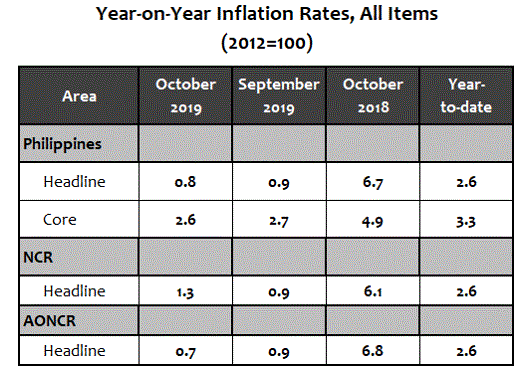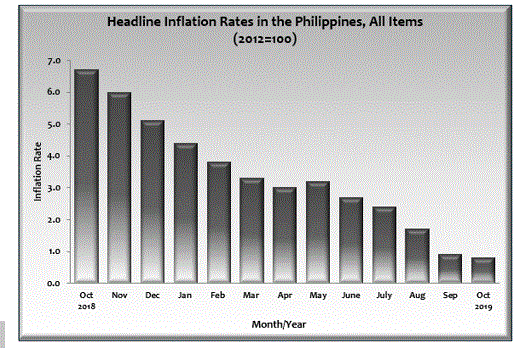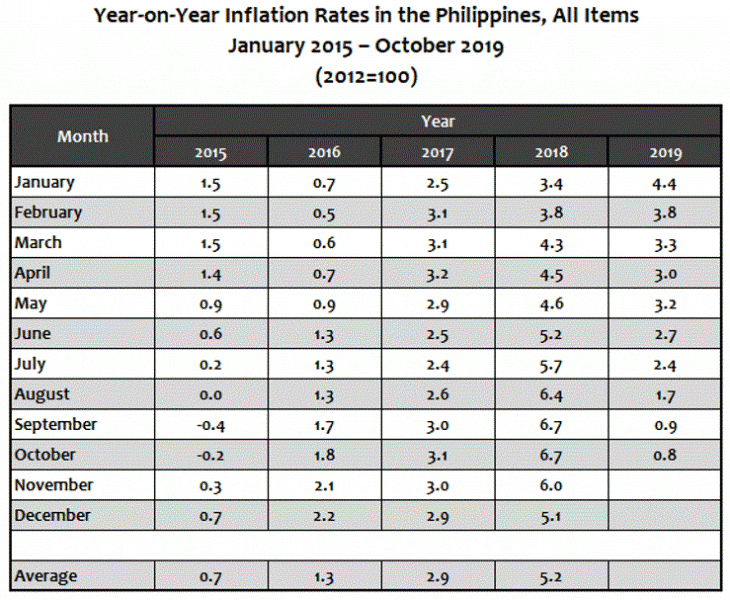YEAR-ON-YEAR
Philippines
Headline inflation at the country level continued to ease to 0.8 percent in October 2019. This is the lowest inflation recorded since May 2016, in which the inflation rate was posted at 0.9 percent.
Inflation in September 2019 was higher at 0.9 percent and in October 2018, 6.7 percent.
The downtrend in the inflation in October 2019 was mainly due to the 0.9 percent annual drop registered in the heavily-weighted food and non-alcoholic beverages index. Similarly, the annual rate of transport index declined further by 1.7 percent during the month. Moreover, slower annual increments were noted in the following commodity groups:
- Housing, water, electricity, gas, and other fuels, 0.6%;
- Furnishing, household equipment and routine maintenance of the house, 2.7%; and
- Health, and restaurant and miscellaneous goods and services, both at 2.9%.
On the contrary, annual increases were higher in the indices of alcoholic beverages and tobacco at 16.5 percent; and clothing and footwear, 2.8 percent. The rest of the commodity groups retained their previous  month’s annual rates (see Tables 3 and 4).
month’s annual rates (see Tables 3 and 4).
Excluding selected food and energy items, core inflation decelerated further to 2.6 percent in October 2019. In the previous month, core inflation was registered at 2.7 percent and in October 2018, 4.9 percent (see Table 9).
The country’s food index was still on a downtrend as it recorded an annual decline of 1.3 percent in October 2019. This was the same rate posted in September 2019. In October 2018, inflation for food was observed at 9.2 percent (see Table 7).
Annual rates declined further in the indices of rice at 9.7 percent; and sugar, jam, honey, chocolate and confectionery, 4.3 percent. In addition, annual decreases were still noted in the indices of corn at 3.9 percent and vegetables at 0.8 percent. Slower annual hikes were also observed in the indices of other cereals, flour, cereal preparation, bread, pasta and other bakery products at 2.8 percent; fish; and oils and fats, both at 0.8 percent; and food products, not elsewhere classified, 6.1 percent.
The index of milk, cheese and egg retained its previous month’s annual rate of 3.1 percent, while the rest of the food groups exhibited higher annual mark-ups during the month (see Table 5).

National Capital Region (NCR)
In NCR, inflation was, however, higher at 1.3 percent in October 2019. Inflation in the area in September 2019 was posted at 0.9 percent and in October 2018, 6.1 percent.
The uptrend was brought about by higher annual increments in the indices of food and non-alcoholic beverages, and clothing and footwear, both registered at 1.8 percent; and alcoholic beverages and tobacco at 10.0 percent.
Meanwhile, lower annual hikes were seen in the indices of health at 2.0 percent; and restaurant and miscellaneous goods and services, 2.9 percent. Moreover, annual rates in the indices of housing, water, electricity, gas, and other fuels dropped by 0.2 percent; and transport, 2.8 percent. Other commodity groups retained their previous month’s annual rates (see Tables 3 and 4).
Areas Outside NCR (AONCR)
Following the same trend of the national level, inflation in AONCR decelerated further to 0.7 percent in October 2019. In the previous month, its inflation was observed at 0.9 percent and in October 2018, 6.8 percent.
Annual declines were still registered in the indices of food and non-alcoholic beverages at 1.4 percent; and transport, 1.3 percent. Slowdowns were also noted in the annual gains of the following commodity groups:
- Housing, water, electricity, gas, and other fuels, 1.0%;
- Furnishing, household equipment and routine maintenance of the house, 3.2%;
- Health, 3.1%; and
- Communication, 0.2%.
The rest of the commodity groups either had higher annual increases or retained their previous month’s annual rates (see Tables 3 and 4).
Twelve regions in areas outside NCR either had negative or lower annual rates in October 2019. The lowest annual rate of -1.3 percent during the month was still observed in Region IX (Zamboanga Peninsula), while the highest inflation of 2.3 percent was recorded in Region III (Central Luzon) (see Table 4).
Note: CPIs and inflation rates by province and selected cities are posted at the PSA website (http://openstat.psa.gov.ph/).
(Sgd) CLAIRE DENNIS S. MAPA, Ph.D.
Undersecretary
National Statistician and Civil Registrar General
See more at the CPI and Inflation Rate page.
